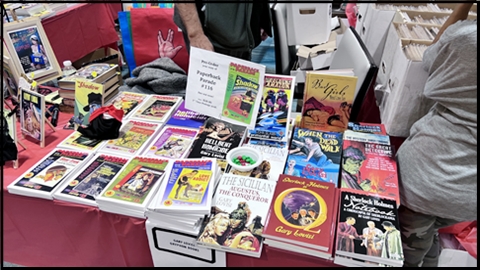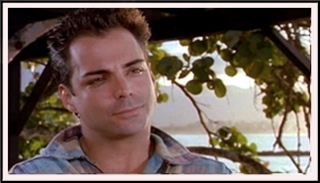November 2022
Monthly Archive
Fri 11 Nov 2022
ANALOG SCIENCE FICTION, April 1967. Editor: John W. Campbell. Cover art by John Schoenherr. Overall rating: **½ stars.

JAMES BLISH & NORMAN L. KNIGHT “To Love Another.†#4 in the authors’ “A Torrent of Faces†series. [The four stories were expanded and combined as A Torrent Of Faces (Doubleday, 1967).] Novelette. A love story between a human woman and tectogenetically created Triton. Too extreme in its contrasts from the depths of the Pacific to the overcrowded city of Philadelphia. The unexpected result that their marriage would produce keeps the story from a lower rating. (2)
MACK REYNOLDS “Enemy Within.†A small child locks himself in a flying saucer. (1)
JOSEPH P. MARTINO “To Change Their Ways.†Novelette. Wilm Kirsten, Sector Supervisor, has to help convince settlers to use new grains to prevent famines. Analogous to problem of India, but one easier to solve. (3)
HARRY HARRISON “The Time-Machines Saga.†Serial; part 2 of 3. [Reprinted in book form as The Technicolor® Time Machine (Doubleday, 1967).] Review of full novel to be posted later.
COLIN KAPP “Ambassador to Verdammt.†The inhabitants of Verdammt, totally alien to alien minds, can control their environment at will. Somewhat the effects of LSD? (4)
Note: Reprinted in World’s Best Science Fiction: 1968, edited by Terry Carr & Donald Wollheim (Ace, paperback, 1968).
–January 1968
Thu 10 Nov 2022
Posted by Steve under
Reviews[2] Comments
REVIEWED BY BOB ADEY:
RICHARD CLAPPERTON – The Sentimental Kill. Peter Fleck #3. Constable, UK, hardcover, 1976. No US edition.
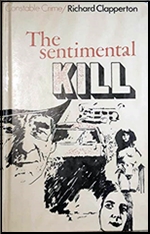
The author’s third novel comes with a dust wrapper blurb which includes review extracts likening his first book to Chandler and his second to Deighton. I couldn’t, frankly, discern such similarity, but I did nevertheless quite enjoy this novel in which Scottish born, Australia based private eye, Peter Fleck, begins the case by acting as protector to former girly magazine publisher, Willie Ansbacher, but spends most of the book trying to locate missing author Temple Wilde.
The connection is that Wilde, now a literary figure of some note, started his career writing Dick Dexter special agent adventures for one of Ansbacher’s early magazines. One particular file copy (of a banned issue) is missing, and perhaps the solution it contained to the then current Dick Dexter adventure could throw light on some more recent real life skullduggery?
Lots of nice twists and turns, and all reasonably logical. Characters interesting, but murderer guessable. I enjoyed it but Chandler or Deighton it isn’t.
– Reprinted from The Poison Pen, Volume 4, Number 3 (June 1981).
Wed 9 Nov 2022
Posted by Steve under
Reviews[14] Comments
REVIEWED BY TONY BAER:
ERNEST HEMINGWAY – To Have and Have Not. Charles Scribner’s Sons, hardcover, 1937. The initial seed for the novel was the short story “One Trip Across,” published in Cosmopolitan, April 1934, and which introduced the character of Harry Morgan. A second portion was published in Esquire, February 1936, as “The Tradesman’s Return.” Reprinted many times. Filmed in 1944, starring Humphrey Bogart and Lauren Bacall.

To Have or Have Not remains the best of the tough novels of its decade and perhaps the best yet written in Americaâ€â€”Tough Guy Writers of the Thirties, ed. David Madden (1968).
Alright. I guess that means I have to read it then, eh? But perhaps, Professor, you can suggest why you think it’s so great?
“The world Hemingway portrays in To Have or Have Not is…the essential milieu of all tough novels, a society so dominated by crime and injustice that law and order have become viciously hypocritical terms. Only power, money, and indomitable individual action make for survival, and if one must survive at the expense of others, so be it. Consequently…a man must sometimes act as a ‘criminal’ in order to win decency and dignity as a man….His toughness is both necessitated and justified by the social jungle he inhabits.†(Madden).
Okay. Well, anyway, the book has nothing to do with the movie. Forget you ever saw the movie — it will only confuse you. Yeah there’s a boat. But that’s about where the similarity stops.
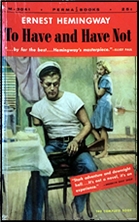
Harry Morgan has a fishing boat that he charters and captains for wealthy tourists in Key West.
What turns everything to shit is that Harry is approaching the end of tourist season and he’s banking on his current big-city client to get him enough dough to make it to next Spring. But the customer ‘dines and dashes’, leaving Harry in the lurch.
So he reluctantly agrees to be wheelman (can you be wheelman on a boat?) in a Key West bank robbery for some Cuban revolutionaries. “[H]e heard a noise like a motor backfiring. He looked down the street and saw a man come out of the bank. He had a gun in his hand and he came running. Then he was out of sight. Two more men came out carrying leather briefcases and guns in their hands and ran in the same direction….The fourth man, the big one, came out of the bank door as he watched, holding a Thompson gun in front of him, and as he backed out of the door the siren in the bank rose in a long breath-holding shriek and Harry saw the gun muzzle jump-jump-jump-jump and heard the bop-bop=bop-bop, small and hollow sounding in the wail of the siren.â€
Once Harry gets them headed towards Cuba, however, it becomes obvious the revolutionaries aren’t planning on leaving any witnesses. So Harry has to do what he has to do to survive. “Crouching low, Harry watched him move until he was absolutely sure. Then he gave him a burst. The gun lighted him on hands and knees, and, as the flame and the bot-bot-bot-bot stopped, he heard him flopping heavily.â€
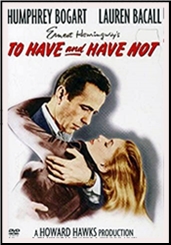
There’s no happy solutions to Harry’s situation, though (unlike Bogie and Bacall). “No matter how a man alone ain’t got no bloody fucking chanceâ€. The only equalizer is “the Colt or Smith and Wesson; those well-constructed implements that end insomnia, terminate remorse, cure cancer, avoid bankruptcy, and blast an exit from intolerable positions by the pressure of a finger; those admirable American instruments so easily carried, so sure of effect, so well designed to end the American dream when it becomes a nightmareâ€.
It’s a good book. And it’s tough. Is it the best of the tough-guy novels? I dunno. I’m too uneducated to say. But it’s boiled a whole lot harder than the movie.
Last thing I’ll say is that one thing the great writers do better than the rest is making the setting part of the story. I knew the book was over when I read the final lines even though more pages were left to turn on my Kindle. I knew it was over. Like the final still in a film. The sea and ship were as much a part of the story as the dialogue. But I didn’t know it until I read the final line. And chills crawled across my neck as I read:
“Through the window you could see the sea looking hard and new and blue in the winter light. A large white yacht was coming into the harbor and seven miles out on the horizon you could see a tanker, small and neat in profile against the blue sea, hugging the reef as she made to the westward to keep from wasting fuel against the stream.â€
Tue 8 Nov 2022
Posted by Steve under
Reviews1 Comment
REVIEWED BY DAVID VINEYARD:
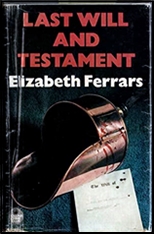
E. X. FERRARS – Last Will and Testament. Virginia & Felix Freer #1. Collins, UK, hardcover, 1978. Doubleday, US, hardcover, 1978. Bantam, US, paperback, 1981. Felony & Mayhem Press, US, softcover, 2021.
“I’m growing wise in my old age. I don’t like taking risks anymore.â€
“I wish I could believe that.â€
“You don’t, you know. You don’t care in the least.â€
“Not very much, perhaps, because the truth is I simply don’t believe you.â€
Virginia Freer has returned home after a long night at the bedside of her dying friend Mrs. Arliss, who passed with a stroke hours earlier, and who should she find stretched out on her sofa but her charming ex Felix who let himself into the house worried because Virginia was out of place.
Virginia long ago saw through Felix and while not divorcing him has removed herself from his charming but inevitably criminous lifestyle (his latest scheme a racket involving selling dubious automobiles).
“…we’ve always remained the best of friends,†he said,…“No need to quarrel just because it happened not to work out too well, living together.â€
Virginia only wants a bath and food and for Felix to go away. She has had a long night and has some unpleasant phone calls to make to Mrs. Arliss surviving relatives. It’s all a bit tiresome, but Felix does make good coffee, and comes bearing an unwelcome gift, that this time he seems to have bought and not pilfered.
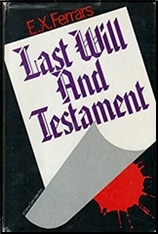
Virginia has a wary eye for Felix. She has her own money, comfortable but not wealthy, a home in the village where she grew up, and a career at a nearby clinic as a physiologist.
Felix showing up just seems a minor annoyance, but whenever Felix is around… And sure enough it turns out the late Mrs. Arliss much coveted estate is gone and no one is inheriting anything. Felix is still hanging around preparing a meal for her when Virginia returns with Meg Randall, Mrs. Arliss companion who just revealed her employers money is gone, gambled or hidden away.
Then during the funeral some valuable minatures go missing from the Arliss home and Virginia starts wondering why Felix showed up to see her in the first place at just that moment. Even if he didn’t take them, is he involved? It looks bad because he not only knows Mrs. Arliss’s former servants the Bodwells, they are at his flat in London when Virginia shows up there.
Well, he’s Felix, of course he’s involved… Isn’t he?
I thought mainly of Felix, feeling the depression that I always did after any meeting with him. It was always so tempting to believe what he said. It promised such comfort and peace.
Elizabeth Ferrars whose editor suggested the E. X. pseudonym was a successful mystery writer whose novels were mostly non series mysteries in the classical mode though she had several series characters including Toby Dyke, and with Andrew Bassett, and the Freers late in her career. Her mysteries tend to be fast moving, smart, and well plotted with attractive characters and well plotted solutions. Her heroines tend to be intelligent and self sufficient and she downplays violence and bloodshed in favor of plot and wit.
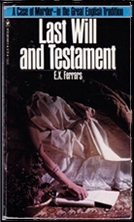
1978’s Last Will and Testament was the first Freers novel and a lively introduction to the two charming protagonists.
Things take a darker turn when the miniatures are returned and one of the heirs in murdered. When the Bodwells are murdered too Felix decides to intervene and from there on it’s a straight murder mystery, just complex enough to keep things interesting and with more than enough charm and wit with Ferrar’s easy unobtrusive but slick style keeping us guessing and the action neatly moving until the crime is solved and Felix almost the hero of the day.
The Freers continued to adventure in much the same manner from 1978 to 1992 in a series of light and well written adventures that managed to be quite modern while still echoing some of the fun of an earlier time. This was my first time encountering the pair, but I can assure you I will spend more time with Virginia and Felix, though in Felix’s case I may check my wallet afterward.
Mon 7 Nov 2022
CON REPORT:
Pulp AdventureCon, November 5, 2022
by Walker Martin
What a beautiful period to have a book and pulp convention! Temperature in the 70’s which is very unusual for November. Though the show is officially only one day. My friends and I celebrate the occasion from Wednesday through Saturday and some years even Sunday.

Ed Hulse.
As usual Matt Moring arrives first on Wednesday and uses the extra time to research and scan pulp covers and contents. This work eventually ends up as the books published by Steeger Books (steegerbooks.com). 600 books, mostly pulp reprints and counting! An amazing achievement.

Walker Martin.
Thursday and Friday, the other pulp collectors arrive and we proceed to have several meals at such restaurants near me as Metro Grill, Bell’s Tavern, Town and Country. Sadly Mastoris Diner, after almost a hundred years, was a victim of the Covid virus restrictions but we noticed that Town and Country looked very similar as to seating and menu.

Cowboy Tony.
I try to keep the Friday brunch down to 10 collectors because that’s all I can handle and control. Yes, control, because these guys are all insane bibliomaniacs (is there such a word?) and to give you an idea here is a listing of the attendees with the years I’ve known them. They all have enormous book and pulp collections:
Digges La Touche–50 years
Scott Hartshorn–46 years
Nick Certo–46 years
Paul Herman–40 years
Andy Jaysnovich–40 years
Ed Hulse–25 years
Richard Meli–25 years
Matt Moring–10 or 12 years
In addition we had a new guest, Peter Wolson, the son of Morton Wolson, who wrote under the name of Peter Paige for Dime Detective, Black Mask, and Detective Tales. Under his own name he also wrote for Manhunt and Ellery Queen Mystery Magazine. Peter collects only the pulps that his father appeared in so he is the only one of our group who has his collecting activities under control.

Though there were many Peter Paige stories in the pulps, he had written only one novel, so when The Complete Cases of Cash Wale appeared from Steeger Books in 2021, his son Peter was surprised and happy to see that his father was still remembered by readers and collectors.
This collection is the first volume reprinting the over 20 Cash Wale and Sailor Duffy stories. Cash was a hard boiled private eye and Sailor was his assistant and strongman. The first couple stories appeared in Detective Tales and Black Mask but the rest of them found a home in Dime Detective during the 40’s and early 50’s. The stories were long novelets and close to 20,000 words each. The author received high word rates since they were so popular. I’ve seen cancelled checks made out to Morton Wolson for $400 to $500 dollars. All the stories were hard boiled, wise cracking private eye yarns told with a sense of style and humor. I highly recommend them and they are available at steegerbooks.com or amazon.

John Gunnison.
Attendance at the convention was between 80 and 100 with many dealers and 42 tables. There were two fairly large rooms and one small one. One big benefit was the free breakfast available at the hotel. I needed the egg sandwich, hash browns and coffee to get me through the day because I’m too excited to waste time taking a lunch break. Yes, “waste time,” because it’s all about the books and pulps!
Unfortunately, I’ve been at the collecting game so long that I no longer need much and I didn’t find many of my wants. But Matt Moring and I shared a table and I sold some Shadow digests, Adventure, Black Mask, and Dime Detective pulps. I saw Matt running back and forth with many pulps that he needed and it made me wish I could relive the old days when I needed a lot and had a big want list.
Speaking of Matt, keep an eye out for the Steeger Books Thanksgiving sale. He showed me over 20 new volumes that will be soon up for sale, including books in the Argosy and Dime Detective series.

Bruce Tinkle with Lucille & Gary Lovisi.
The rooms were busy all day long, especially the tables manned by John Gunnison (five!), Cowboy Tony, Paul Herman, and Michael Brenner.
I’d like to thank the organizers of this excellent show: Rich Harvey and Audrey Parente. Also thanks to Rich’s father who has been in charge of taking attendance since the first show over 20 years ago. The photos were taken by Paul Herman. Thanks Paul! And thanks to all my collector friends for making this another memorable occasion.
Hope to see you at Windy City and Pulpfest!
Mon 7 Nov 2022
Posted by Steve under
Reviews[5] Comments
REVIEWED BY TONY BAER:
A. H. Z. CARR – Finding Maubee. Putnam, hardcover, 1971. Bantam, paperback, 1973. Edgar Winnerin 1972 for Best First Mystery. Film: MGM, 1989, as The Mighty Quinn (reviewed here ).
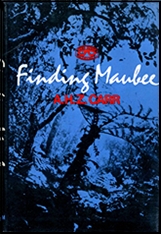
So aside from the fact that I’m into American mid-century hardboiled writing, when looking for my next read, one of my rules of thumb is to target books that somebody somewhere that I respect has endorsed. Life’s too short for me to read everything. And it’s especially too short to waste what little time I have reading crap. Reading nourishes me and helps me to keep going. These (generally) dead writers are my friends. We understand each other. And if someone cool has read a mid-century hardboiled book and enjoyed it, then I figure I should be also capable of experiencing similar enjoyment. If I fail to experience similar joy the failure is all mine. It’s not like anyone is paying me to read books — it’s me that paying for the privilege with my money and my time. I read for the experiences a book provides me with and the time I get to spend in the author’s company. And if the experiences are not valuable, it’s my loss and mine alone.
There’s a number of lists out there from which I draw (James Sandoe and Geoffrey O’Brien, for example). Another nice list of books comes courtesy of J. Kingston Pierce’s much beloved blog The Rap Sheet:
http://therapsheet.blogspot.com/2007/05/ones-that-got-away.html.
Robert Randisi’s choice of the most criminally neglected novel was Finding Maubee:
“I choose Finding Maubee, by A. H. Z. Carr. When it came out in 1972 it won the Edgar for Best First novel. [It’s] a procedural set in Jamaica, which was made into an enjoyable 1989 movie with Denzel Washington, called The Mighty Quinn. Unfortunately, before [Carr] could write any more, or–I believe–even before the book was published, the author died. … I would have loved to see what this author would have done next.â€
http://therapsheet.blogspot.com/2007/05/youre-still-one-part-iv.html
It’s quite pricey, but I was able to read it via the indispensable Internet Archive:
https://archive.org/details/calypsomurders0000carr.

The book centers around the relationship between the police chief, Xavier Brooke, and his childhood friend David Maubee. Maubee is a famous local Don Juan, who has fathered so many children out of wedlock that he has taken to petty theft to pay all of his paternity obligations. He’s so legendary that the islanders of the fictional American Island St. Caro sang a calypso that goes:
“Let us tell you the story of David Maubee,
Who sought for a life of tranquilitee.
He had to pay money to eight different women,
So now he robs tourists while they are swimmin’.
He have found the way of life which is safest and surest—
Like all of us here he live on the tourist.â€
The police left Maubee alone in his gigolo induced petty thievery because local sentiment was on his side. Another popular calypso goes:
“Police don’ wan’ get Dave Maubee sore
Cause provocation is against the law.â€
The uneasy truce between the police and David Maubee comes to an end, however, when a rich American industrialist is found slain by a machete bearing Maubee’s fingerprints, Maubee’s little black book laying by the slain man’s side.
The American governor of the island, Governor Chalk, has ordered the police to arrest Maubee at once. Dead or alive. No autopsy necessary. We can’t have this island tourist destination soiled by the scandal of unsolved murder of rich American tourists.
Ignoring orders, and at the risk of hearth and home, Police Chief Xavier Brooke has an autopsy performed. It turns out that the victim was poisoned to death before the staged slaying.
Governor Chalk won’t believe the autopsy, however. And he gives Xavier 24 hours to catch Maubee and/or prove someone else is the murderer. If he doesn’t solve it in time, Xavier’s chief deputy has Chalk’s ear, with knives out to take Xavier’s job (and wife) from him.
It’s a very enjoyable Caribbean detective story. A bit reminiscent of the Jo Gar stories for the island atmosphere and the gentility and cultured manners of the local police chief who navigates local customs and superstition with the finesse necessary for native cooperation.
It gets a bit too talky at the end, where we have the tired mechanism of having all the suspects show up in one room to finagle a confession. But I can forgive this cliched ending for what, prior to the denouement, was an original, touching story of an unlikely friendship between law and outlaw outlasting hypocritical colonialist efforts to subvert a difficult justice in the interests of tourism.
Sun 6 Nov 2022
MARKER. “The Pilot.†UPN, 17 January 1995 (Season 1, Episode 1). Richard Grieco, Gates McFadden, Keone Young, Andy Burnaabel. Guest star: Nia Peeples. Created and written by Stephen J. Cannell. Director: Dennis Duggan. Currently streaming (with ads) on Freevee.
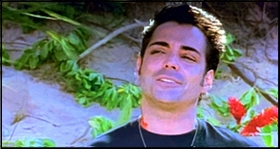
It may be stretching things a bit to call Marker a Private Eye show, but on the basis of this first episode only, I don’t see any reason why not. When Richard DeMorra (Richard Grieco), a carpenter living in New Jersey who travels to Hawaii to attend the funeral of his estranged father, he clashes immediately with his stepmother over the estate, but he also learns that his father had a habit of passing out markers for people to use whenever they needed a helping hand.
And such a person is a championship surfer girl (Nia Peeples) whose sister has disappeared, and she is hoping that Richard will honor his father’s promise to help find her. It is strongly suggested that further episodes will center on other such “clients†holding similar markers.

It doesn’t take a lot of effort to solve this first case. Most of its running time is taken up by establishing the basic setup and the rules of the game. Richard ruminates a lot about his father, but it is left to later episodes (perhaps) to explain the why of the estrangement, a serious omission, I thought, one which let me hanging.
Richard Grieco (who attended Central Connecticut State University, where I taught for some 30 years) was at the time known as a “hunk†but is also moderately successful here as an actor. The story line does show some promise, but other than the promise, this first case is awfully dull. The series lasted for only half a season, or 13 episodes.
Sat 5 Nov 2022
Posted by Steve under
Reviews[5] Comments
GEORGE GOODCHILD – The Monster of Grammont. Hodder & Stoughton, UK, hardcover, 1927. Mystery League, US, hardcover, 1930.
I try to read at least one spooky book this time of year, and this year it was George Goodchild’s elusive novel, The Monster of Grammont.
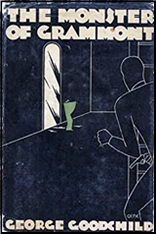
I say “elusive†because I have seen this book at used book stores three times. The first two times I set it aside and someone else got it while I wasn’t looking. The third time I bought it with no difficulty, only to have it disappear for two weeks when I was halfway through it — turned out some idiot set a pile of junk overtop it while I was working in my basement. Terrible the help one gets these days. But I digress….
Monster starts off quite well, with two doughty Englishmen motoring through post-WWI France on Holiday, stopping at a chateau where one of them convalesced thanks to the hospitality of the owner, Count Fallieres, and finding the Count and his beautiful daughter (“She was just a child when I was here last…â€) beset by a nasty old ghost.
And when I say “nasty old ghost†I mean every inch of that phrase. No pallid whining blob of ectoplasm, this supernatural visitor is big, ugly, ill-tempered and quite capable of nailing doughty Englishmen to the floor when they venture too near, which our heroes do early on and often thereafter.
This sustains the first several chapters quite nicely, as everyone darts about the chateau in pursuit of the ghostly vandal until Fallieres get murdered for his trouble and Police Detective Fouchard is sent to investigate.
Only Fouchard doesn’t show up right away; an impostor takes his place and promptly vanishes when the real Fouchard shows up. Which sets up a whole different plot involving kidnappings, more impersonations, car chases, bombs, and still more plotting, till the Monster of Grammont gets rather displaced by all that mucking about.
Which is a shame, because the Monster was an entertaining brute, and the plot that replaces his antics seems tame and tepid by comparison. Worse yet, the story wraps up with a burst of niceness sure to disappoint readers who followed the earlier, nastier passages as avidly as I did.
There is a certain amount of charm in the attitudes and impressions of our post-Victorian heroes, but readers looking for an authentic chill had best put this down and seek elsewhere.
Sat 5 Nov 2022
DAVID McDANIEL – The Vampire Affair. The Man from UNCLE #6. Ace, paperback original, 1966.
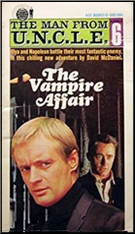
When an agent for UNCLE is found dead, his body drained of blood in the Transylvanian hills, Napoloeon Solo and Illya Kuryakin are sent to investigate. No one want to even suggest the obvious, but after a while even the obvious cannot be denied.
That quick summary is about all there is to the story. David McDaniel is a good writer, but you can also hint at things supernatural only so long before the hints become hokey. You probably know what is really happening, if not why, as well and as soon as I did all the way through.
One point of interest, quite unexpected, though, is a chapter-length cameo by Forrest J Ackerman, editor and primary writer for the then current magazine Famous Monsters of Filmland and a self-proclaimed expert on both vampires ad werewolves. His presence doesn’t add anything to the plot, and in fact it may take you (jarringly) out of the story for a moment or two.
I think McDaniel captures the camaraderie between the two stars rather well, without overdoing it. But if it’s UNCLE you want, you would be better picking up a set of DVDs for the show — an option, however, I know fully well was not available back in 1966.
Fri 4 Nov 2022
Posted by Steve under
Reviews[4] Comments
REVIEWED BY BOB ADEY:
JAMES ANDERSON – The Affair of the Blood-Stained Egg Cosy. Chief Inspector Wilkins #1. Constable, UK, hardcover, 1975. David McKay, US, hardcover, 1977. Avon, US, paperback, 1978. Poisoned Pen Press, US, softcover, 1998.
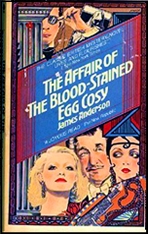
In this book Mr. Anderson has attempted and pretty well succeeded, in recapturing the spirit of the pre-war era. The setting is a weekend house party in a stately home, the flavouring that of international intrigue, and the characters the full range of golden age products — the titled hosts, American millionaires, a penniless deb, a mysterious stranger, some diplomats, a foreign countess, etc. etc.
But whereas the genuine thirties article also often contained unreal dialogue, ridiculous characters, a meandering plot with a hopelessly weak denouement, this does not. The build-up is beautifully done and leads to a storm-ridden night when all hell lets loose — jewelry is stolen (could it be the work of a master criminal, the Wraith?), guns are missing, there are constant comings and goings — and murder is done.
The police in the form of unconventional Inspector Wilkins carry out a detailed investigation and in a marvelous revelation scene the pieces of the jigsaw are put together and the truth emerges.
An affectionate study, and quite a tour de force.
– Reprinted from The Poison Pen, Volume 4, Number 3 (June 1981).
« Previous Page — Next Page »














